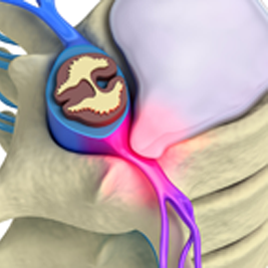What is a Herniated Disc?
Also referred to as a slipped disc or ruptured disc, a herniated disc can occur anywhere in the spine. Most often, it occurs in the cervical spine (neck) or lumbar spine (lower back), typically causing “a pinched nerve.”
If you are experiencing pain or numbness in the neck, arm, lower back, or leg, you could be suffering from a herniated disc. Our expert pain management doctors use innovative procedures to accurately diagnose your pain and safe, non-surgical procedures to alleviate the excruciating pain caused by your herniated disc.

Why Do Herniated Discs Develop?
Discs are soft, rubbery pads located between the bony vertebrae that make up the spinal column. Composed of a thick outer ring of cartilage (annulus) and an inner gel-like substance (nucleus), discs allow the back to bend and also act as shock absorbers. The spinal column surrounds and protects the spinal cord and nerves. When the cartilage develops a defect or tear, the nucleus can break through. Much like toothpaste, the nucleus bulges out or herniates, putting pressure on the nerves. Even slight amounts of pressure can cause pain, numbness, or weakness.
A herniated disc in the lower spine can put pressure on the sciatic nerve (sciatica). The sciatic nerve is comprised of several spinal nerve branches as they travel from the spine down the length of the leg. When pinched, sciatic pain may be experienced anywhere along these branches, radiating from the buttocks down the back of the leg and sometimes through the shin and foot. Often, leg pain occurs without any back pain.
Herniated Disc Symptoms
Symptoms of a herniated disc can be different depending on where the injured disc is located. Low back pain and/or leg pain (sciatica) are the most common symptoms of a herniated disc in the lumbar (lower) spine. Pain may vary from mild to severe. Symptoms may be experienced suddenly or gradually and may also include:
- Pain in both legs
- Burning, tingling (a “pins–and–needles” sensation), or numbness in the buttock, leg, or foot
- Pain with specific movements, usually bending forward or twisting
- Intensified pain with prolonged sitting, bending, sneezing, or coughing
- Weakness in one or both legs
- Loss of bladder or bowel control (note that this is rare)
Diagnosis
Proper diagnosis starts with an experienced pain management doctor. The type of pain that you may have with a herniated disc can be similar to the symptoms of several types of disorders. Accurately determining the correct source of your pain is critical to successful treatment.
- Begins with a thorough clinical evaluation
- Including a complete medical history, analysis of your symptoms, and physical examination
- Testing may include x-rays, MRI and/or CT scans, and electro-diagnosis (EMG)
- These advanced diagnostic techniques definitively pinpoint the source of pain
We're Here to Help get Your Life Back
